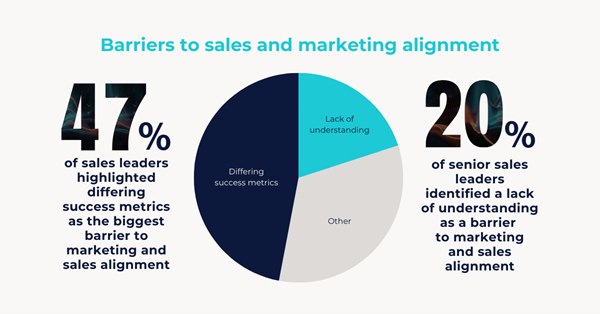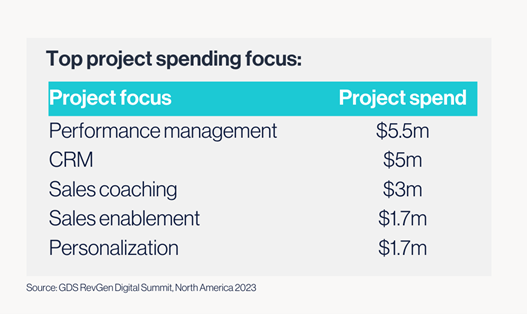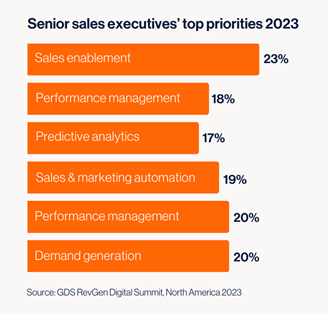Table of contents:
Sales and marketing departments have always held pivotal roles across businesses in many industries. These departments have operated in parallel, each with its own unique strategies and success metrics. However, the over-arching goal has always remained the same on both sides: revenue growth and business success.
United with these shared objectives, both senior sales and marketing executives understand the importance of keeping a close eye on budgets, priorities, and challenges.
However, with a noted lack of understanding reported between these two cornerstones of revenue generation, many are seeking a path towards sales and marketing alignment. This will maximize the developments of both departments and create not just an effective revenue generation team, but a revenue powerhouse.
Furthermore, in the fast-paced world of revenue generation, keeping up with industry trends can be overwhelming – that’s why we’ve collected data from 399 senior sales and marketing executives representing Fortune 500 companies to deliver sales and marketing insights straight to you, so that the path to sales and marketing alignment can become clear for your business.
So – what does sales and marketing alignment entail?
Sales and marketing alignment is not just a corporate buzzword; this synchronization is the foundation of a thriving revenue powerhouse.
Despite sales and marketing ultimately sharing one key goal: driving sales and revenue, traditionally, many businesses find these two departments operating in separate silos.
Alignment, then, seeks to break down these separate silos and allow sales and marketing to work in tandem with each other.
This can be achieved in numerous ways, but often entails developing shared goals, metrics and strategies that can be understood and used across both teams. One method includes having marketing teams focus on the quality and readiness of leads, ensuring that those passed on to sales are more likely to convert, creating a smoother lead conversion process.
As well as this, opening clearer lines of communication between the departments is a key suggestion for developing sales and marketing alignment. This could be done through regular cross-functional meetings, which will enable both sides to regularly check in with each other and develop a coherent understanding of the buyer’s journey in both a marketing and sales context. Furthermore, open communication between the teams ensures that each department has access to essential resources and can communicate any needs or questions effectively.
Essentially, the focus of sales and marketing alignment is developing strategies and methods that will allow the two teams to work cohesively and effectively.
How can sales and marketing alignment benefit revenue generation?
The benefits of sales and marketing alignment can be seen across many different aspects of a business. This harmonization has been seen to not only improve the outcomes for sales and marketing departments, but improve revenue generation, reaping benefits for the wider business, with a multitude of improvements.
One key area that demonstrates clear improvement with aligned sales and marketing teams is lead generation. Alignment ensures that marketing efforts focus on enhancing lead quality, increasing the likelihood of conversion. In turn, this also develops shortened sales cycles, as with more qualified leads, the sales cycle can be expedited allowing the sales team to focus on closing deals.
The use of data-driven insights across both teams also proves to be a key benefit – by sharing metrics and analytics both teams can make data-driven decisions that can drive more targeted and effective marketing campaigns and sales strategies. As well as this alignment prevents duplication of efforts and resources, enabling efficient use of budgets, time, and manpower across both departments, truly optimizing business resources.
Furthermore, a cohesive approach improves customer experience, by ensuring consistency in messaging and customer interactions. In turn, this enhances overall customer experience and loyalty. Collaborative efforts can also ensure a quicker response to market changes and trends, allowing the business to adapt its strategies promptly, thereby capitalizing on emerging opportunities for revenue growth.
It is clear then, that by working in harmony, sales and marketing alignment leads to more effective campaigns and strategies, resulting in a higher return on investment for both departments and the business as a whole.
Resistance to sales and marketing alignment
While it appears evident that sales and marketing alignment can reap benefits for not just sales and marketing departments but the business as a whole, challenges to achieving this synergy between the departments have arisen.
Senior sales leaders have acknowledged the importance of this move towards synchronization for marketing and sales teams, yet 47% of them highlight concerns around differing success metrics used within the two teams. These different approaches to measuring success are considered to be one of the biggest barriers to marketing and sales alignment. 20% have highlighted a lack of understanding between the two as a key barrier, with poor intra-departmental communication also being noted as a difficulty that alignment faces.

These areas, while challenging to address, may not be as formidable obstacles as they first appear. Combatting a lack of understanding and poor communication could be resolved through small changes in company culture. However, senior marketing executives have identified this as one of their most difficult areas to address.
Despite these difficulties, changes are beginning to be set in motion, with senior sales executives highlighting leadership development as a top spending focus area at our recent RevGen Digital Summit, with an average $14m budget allocation.
With the right change management and engagement, the realization of sales and marketing alignment, while not a quick fix, is certain to reap rewards.
Unveiling the sales and marketing statistics
One thing that can be agreed upon for both marketing and sales leaders is the importance of data-driven insights. Data has become the center of informed decision making, across many departments and industries.
By unveiling data collected from 399 senior sales and marketing executives at our digital summits, we hope to bring a unified understanding of both marketing and sales in the fast-paced, ever-evolving realm of revenue generation.
Reviewing data as not just marketing-focused or sales-focused, but surrounding revenue generation, holistically, is one step towards understanding both sides of the data story and aligning your marketing and sales strategies.
Sales and marketing budgets
Our latest insights highlight a staggering 334% surge in total budgets reported by senior marketers since 2022. The average marketing budget has soared to an impressive $21,153,846, underscoring the significance of the strategic role that marketing teams are expected to play in the future.
Likewise, sales budgets have also experienced an uptick, with the average budget increasing from $17.7m to $18.4m. While not as dramatic an increase as the marketing budget, this increase demonstrates the unwavering importance of sales departments.

These increases can likely be attributed to the pervasive influence of data-driven methodologies. An ongoing influence in many aspects of C-level decision making, the transformative power of understanding data has been seen across areas such as in understanding clients, nurturing robust relationships, and venturing into uncharted markets, as well as in propelling significant increases in both sales and marketing budgets.
With respect to the alignment of sales and marketing teams, the increase in budget demonstrates the importance of both departments. This suggests that teams should not be competing for individual budget assignments, but recognizing the key role that each department can play.
Optimizing sales and marketing project spend
In the budget resurgent landscape of 2023, the stakes for sales and marketing teams have never been higher. The imperative to allocate resources judiciously and yield substantial returns has intensified, casting a spotlight on the strategic acumen of these departments.
Despite the expansion of individual budgets for sales leaders, there has been a noticeable shift in budget distribution, with an overall reduction in allocation for projects. However, top project spending focuses include areas such as performance management and sales enablement.

On the marketing front, a wave of increased investment has surged, with a significant portion earmarked for consumer insights and market research, totaling a staggering $55 million. This targeted approach underscores the industry’s dedication to understanding the pulse of consumers, equipping marketers with unparalleled insights to craft compelling narratives and drive impactful campaigns.
Top priorities for senior executives
While budget allocation is one key marker of the areas demanding focus for our senior sales and marketing leaders, other priorities have made their way to the forefront in our data.
For marketers, brand strategy and engagement, content marketing, and data-driven marketing are primary concerns. Brand has continued to be a key priority over the last few years, with a strong emphasis on uniting the development of a compelling brand while delivering a clear value proposition. This is particularly important during times of economic instability to ensure that you stay top-of-mind when your audience is ‘in-market’ to make a purchase. Content also continues to take priority as marketing executives place it as one of their top concerns. Not surprisingly, it is also the second biggest challenge noted by senior executives.

While brand and content are major concerns for marketers, it’s sales enablement that is front of mind for senior sales executives. Our data shows that sales enablement has been a priority for a number of years. However, in 2023, demand generation entered the top priorities list for the first time. This signals a move in the right direction towards tighter alignment between sales and marketing teams.

Furthermore, sales executives also identified lead generation and conversion as their top worry, closely followed by sales and marketing alignment. It is clear then, that senior sales leaders have understood the imperative of forging stronger collaborative bonds with their marketing counterparts as the cogs that maintain the running of the revenue powerhouse.
What does this mean for alignment?
In conclusion, our findings underscore a compelling narrative: the future of successful businesses lies in the convergence of sales and marketing efforts. A clear trajectory towards sales and marketing alignment has begun, positioning this synergy as the path to achieving revenue success. By recognizing the potential of this collaboration, businesses can unlock their full growth potential, increase revenues, and achieve future success as a formidable revenue powerhouse.
Understanding the data for both departments in conjunction can provide a clearer insight into how these two differing roles can work in tandem and push each other’s development.
[Infographic] Sales + Marketing: Creating a revenue powerhouse
For a deeper dive into the intricate dynamics of sales and marketing in 2023, we invite you to explore our latest infographic – Sales + Marketing: Creating a revenue powerhouse. It’s more than just information; it’s your guide to unlocking unparalleled growth and prosperity in the competitive landscape of today and tomorrow












